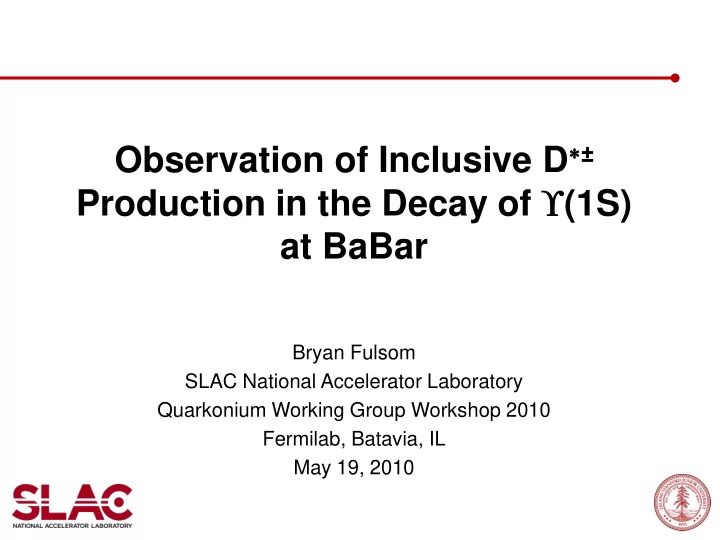

Observation of Inclusive D ± Production in the Decay of (1S) at BaBar Bryan Fulsom SLAC National Accelerator Laboratory Quarkonium Working Group Workshop 2010 Fermilab, Batavia, IL May 19, 2010
Talk Outline • Background – Previous Theory and Experiment • Analysis – Reconstruction and Selection – Background Subtraction – Fit Method • Conclusions – Results – Systematic uncertainties and cross-checks – Interpretation (1S) D ± + X / Bryan Fulsom / QWG 2010 / 2010.05.19 / Page 2
Introduction • Only ~10% of (1S) decays have been measured • Dominant decay mode: (1S) ggg • (1S) D ± + X expected to proceed via: – Virtual photon annihilation with hadronization – Higher-order contributions from color singlet and octet (1S) D ± + X / Bryan Fulsom / QWG 2010 / 2010.05.19 / Page 3
Introduction • Theoretical calculations for (1S) decays – (1S) D ± + X momentum distribution prediction – QED and color singlet dominate, but color octet may be non-negligible – May be up to ~50% of color singlet c bJ decay: color octet ~9% of color singlet • • (1S) decays to open charm not yet observed – BF( (1S) D ± + X) < 1.9 % (1S) D ± + X / Bryan Fulsom / QWG 2010 / 2010.05.19 / Page 4
The BaBar Experiment (1S) D ± + X / Bryan Fulsom / QWG 2010 / 2010.05.19 / Page 5
Analysis Strategy • Reconstructed decay chain: • Identify (2S) p + p - (1S) events by recoil mass: • Subtract p + p - sideband and wrong-sign decay backgrounds • Fit yield from m D0 distribution in bins of scaled momentum: (1S) D ± + X / Bryan Fulsom / QWG 2010 / 2010.05.19 / Page 6
Selection Criteria • MC m p+p- tuned to match CLEO • M recoil includes sidebands • m(D ) – m(D 0 ) to select D (1S) D ± + X / Bryan Fulsom / QWG 2010 / 2010.05.19 / Page 7
Combinatoric Background • Define “wrong sign” sample (D ± D 0 p - , D 0 K - p + ) – Fake soft pions in D or D 0 candidate (dominant) – Doubly Cabibbo suppressed (D - D 0 p - , D 0 K - p + ) (0.4%) – K and p double-misidentification (<0.02%) (1S) D ± + X / Bryan Fulsom / QWG 2010 / 2010.05.19 / Page 8
Dipion Sideband Subtraction • Subtract m D0 distribution from M recoil sidebands – Real D / Non – (2S) p + p - (1S) backgrounds • Scale m D0 distribution to signal region and subtract – Ratio: linear (sideband) / double-Gaussian (signal) (1S) D ± + X / Bryan Fulsom / QWG 2010 / 2010.05.19 / Page 9
Signal Extraction • Signal yield from fit to m D0 in slices of x p = [0.1,1.0] • PDF parameterization: – f, s 1 , s 2 determined from MC – m from full x p range data • Parameterization stability verified on MC across x p (1S) D ± + X / Bryan Fulsom / QWG 2010 / 2010.05.19 / Page 10
Efficiency • Determined from fits to MC in slices of x p • x p < 0.1 dominated by combinatorial background (1S) D ± + X / Bryan Fulsom / QWG 2010 / 2010.05.19 / Page 11
Results • n sig = 11845 ± 596 • Derived QED contribution: • Apply this normalization to fragmentation function (1S) D ± + X / Bryan Fulsom / QWG 2010 / 2010.05.19 / Page 12
Cross-Checks • Off-resonance fit consistent with 0 events • Alternate fit to M recoil returns consistent results (1S) D ± + X / Bryan Fulsom / QWG 2010 / 2010.05.19 / Page 13
Systematic Uncertainties p reconstruction • – D D 0 p: p p related to q – De between data / MC • M recoil – Peak differs in MC and data – Fit with double-Gaussian – Compare De • B decay – B( (2S) p + p - (1S)) • x p distribution – Fit empirically – Reweight and refit MC (1S) D ± + X / Bryan Fulsom / QWG 2010 / 2010.05.19 / Page 14
Discussion and Conclusion • B( (1S) D ± + X) = (2.52 ± 0.13 ± 0.15)% • x p >0.75: consistent with QED • x p <0.75: significant excess • P( c 2 ) = 1.6 x 10 -5 • Exceeds QED by (1.00±0.28)% (3.6 s ) • Consistent with color singlet prediction (1.20 ± 0.29)% • Disfavors large color octet contribution • For full details, please see our publication: (1S) D ± + X / Bryan Fulsom / QWG 2010 / 2010.05.19 / Page 15
Recommend
More recommend